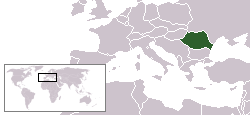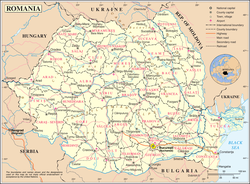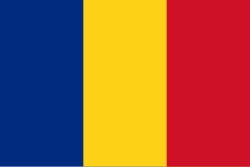

The following outline is provided as an overview of and topical guide to Romania:
Contents
- General reference
- Geography of Romania
- Environment of Romania
- Regions of Romania
- Demography of Romania
- Neighbours of Romania
- Government and politics of Romania
- Branches of the government of Romania
- Foreign relations of Romania
- Law and order in Romania
- Military of Romania
- Local government in Romania
- History of Romania
- History of Romania, by period
- History of Romania, by region
- History of Romania, by subject
- Culture of Romania
- Art in Romania
- Languages of Romania
- People of Romania
- Religion in Romania
- Sports in Romania
- Economy and infrastructure of Romania
- Education in Romania
- See also
- References
- External links
Romania – unitary semi-presidential republic located in Central-Southeastern Europe, bordering the Black Sea to the south-east, between Bulgaria and Ukraine. It also borders Hungary to the west, Serbia to the south-west, and the Republic of Moldova to the east. It covers 238,391 square kilometres (92,043 sq mi) and has a predominantly temperate continental climate.
With c. 19 million inhabitants (as of early 2022), it is the seventh most populous member state of the European Union (EU). Its capital and largest city, Bucharest, is the fourth largest city in the EU. It encompasses the historical regions of Wallachia (including Dobruja), Moldavia (including Bukovina), Transylvania (including Banat, Maramureș, and Crișana). Romania derives from the Latin romanus, meaning "citizen of Rome".






